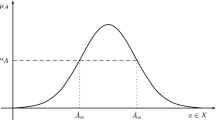Abstract
One way to increase the power of Qualitative Spatial Reasoning is to introduce proximity operators (such as close and far) that are surrogates for distance measures. These operators appear to be semi-quantitative in nature as opposed to purely qualitative. In the light of observations drawn from psychometric testing of perceived proximity, this paper discusses how a model to support proximal reasoning could be constructed. The relationships between the model and the raw data are described. Fuzzy set membership is used to reason about the degree of closeness. The formulation of queries involving proximity is presented, with the meaning of linguistic variables being instantiated within a given context at execution time.
Preview
Unable to display preview. Download preview PDF.
Similar content being viewed by others
References
Cressie N A C (1993), Statistics for Spatial Data. John Wiley and Sons, USA, Ch. 8.
Dutta S (1990), Qualitative Spatial Reasoning: A Semi-Quantitative Approach Using Fuzzy Logic. In: Design and Implementation of Large Spatial Databases (Eds. Buchmann A, Günther O, Smith T R and Wang Y-F) Springer-Verlag, New York, pp 345–364.
Egenhofer M J and Franzosa R D (1991), Point-Set Topological Spatial Relations. Int. J. Geographical Information Systems, Vol. 5, No. 2, pp 161–174.
Frank A U (1992), Qualitative Spatial Reasoning about Distances and Directions in Geographic Space. Journal of Visual Languages and Computing, Vol. 3, pp 343–371.
Gahegan M N (1994), Support for the Contextual Interpretation of Data Within an Object-Oriented GIS. Proc. Spatial Data Handling '94, (Ed. Waugh T C and Healey R G), pp 988–1001, Edinburgh, Scotland.
Gapp K-P (1994), A Computational Model of the Basic Meanings of Graded Composite Spatial Relations in 3D Space. Proc. Int. Workshop on Advanced Geographic Data Modelling (AGDM '94), (Ed. M Molenaar and S De Hoop), pp 66–79, Delft, Netherlands.
Guttman L (1968), A General Nonmetric Technique for Finding the Smallest Coordinate Space for a Configuration of Points. Psychometrika, Vol. 33, No. 4, pp 469–506.
Lundberg U and Ekman G (1973), Subjective Geographic Distance: A Multidimensional Comparison. Psychometrika, Vol. 38, No. 1, pp 113–122.
Molenaar M (1994), A Syntactic Approach for Handling the Semantics of Fuzzy Spatial Objects. Proc. European Science Foundation, GISDATA, Baden, Austria.
Richardson D E (1994), Generalization of Spatial and Thematic Data Using Inheritance and Classification and Aggregation Hierarchies. Proc. Spatial Data Handling '94, (Ed. Waugh T C and Healey R G), pp 957–972, Edinburgh, Scotland.
Roberts S A, Gahegan M N, Hogg J and Hoyle B S, (1991), Application of Object-Oriented Databases to Geographic Information Systems. Information and Software Technology, Vol. 33, No. 1, pp 38–46.
Roberts S A and Gahegan M N, (1991), Supporting the Notion of Context Within a Database Environment for Intelligent Reporting and Query Optimisation. European Journal of Information Systems, vol. 1, no 1, pp 13–22.
Robinson V B (1990), Interactive Machine Acquisition of a Fuzzy Spatial Relation. Computers and Geosciences, Vol. 16, No. 6, pp 857–872.
Sharma J, Flewelling D M and Egenhofer M J (1994), A Qualitative Spatial Reasoner. Proc. Spatial Data Handling '94, (Ed. Waugh T C and Healey R G), pp 665–681, Edinburgh, Scotland.
Smith T R and Park K K (1992), Algebraic Approach to Spatial Reasoning. Int. J. Geographical Information Systems, Vol. 6, No. 3, pp 177–192.
Worboys M F, Hearnshaw H M, Maguire D J (1991), Object-Oriented Data and Query Modelling for Geographical Information Systems. Proc. 4th International Symposium on Spatial Data Handling, (Ed. Brassel K & Kishimoto H), Dept. of Geography, University of Zurich, Switzerland, Vol. 2, pp 679–688.
Zadeh L A (1975), The Concept of a Linguistic Variable and its Application to Approximate Reasoning. Information Sciences, Vol. 8 pp 199–249 (part I), Vol. 8 pp 301–357 (part II), Vol. 9 pp 43–80 (part III).
Zimmermann H J and Zysno P (1980), Latent Connectives in Human Decision Making. Fuzzy Sets and Systems, Vol. 4, pp 37–51.
Author information
Authors and Affiliations
Editor information
Rights and permissions
Copyright information
© 1995 Springer-Verlag Berlin Heidelberg
About this paper
Cite this paper
Gahegan, M. (1995). Proximity operators for qualitative spatial reasoning. In: Frank, A.U., Kuhn, W. (eds) Spatial Information Theory A Theoretical Basis for GIS. COSIT 1995. Lecture Notes in Computer Science, vol 988. Springer, Berlin, Heidelberg. https://doi.org/10.1007/3-540-60392-1_3
Download citation
DOI: https://doi.org/10.1007/3-540-60392-1_3
Published:
Publisher Name: Springer, Berlin, Heidelberg
Print ISBN: 978-3-540-60392-4
Online ISBN: 978-3-540-45519-6
eBook Packages: Springer Book Archive




